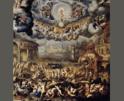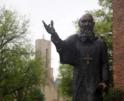
Faith
There are so many devotions and expressions of popular piety within our church and across the globe that you probably cannot catalog them.

O’Grady
Recently, I was asked, "Is the Easter Bunny pagan?" Apparently, some priest told this individual that the Easter Bunny was pagan, and so should not be in Catholic environs. I had never heard of this, so I did some checking. I am, of course, aware that there are many "pagan" dates: Feb. 22 (Chair of Peter); probably Dec. 25; customs: evergreen trees at Christmas; and endless foods -- most of them not good for your waist but excellent to your taste -- that have been brought into Catholic life.
Then there are "ecumenical" ones: Advent Wreaths came to us through the Lutherans, and Easter Eggs from the Eastern churches.
Then there is literature, art, and architecture. Basilicas were "pagan" marketplaces -- the first malls. Some of them were built precisely as ancient malls and became churches. Some churches were subsequently built on the model of basilicas.
Thus, it is advisable to be cautious about jettisoning dates, buildings, foods, or customs simply because they have a so-called pagan origin. Sometimes, we brought them into the church because of the piety and devotion of new Christians, who were previously "pagans."
There are so many devotions and expressions of popular piety within our church and across the globe that you probably cannot catalog them. An initial attempt was made in December 2001 with the release of a substantial document "Directory on Popular Piety and the Liturgy" (www.vatican.va/roman_curia/congregations/ccdds/documents/rc_con_ccdds_doc_20020513_vers-direttorio_en.html). It is substantial both in its length -- well over 200 printed pages -- and its contents.
The document provides a sound theology of various devotions, pious customs and practices, the relationship that should exist between these devotions and the sacred liturgy, and the gestures, images, places, and times associated with these devotions.
The first part reviews in detail and in three separate chapters the history, the development, and the theological principles that should accompany all such practices and devotions.
The second part, the longer of the two, provides us with a call to evaluate and review common devotions.
Next, there is a list of many, but not all, devotions that mark and attend days during the church's years. A few of those are the Christmas creche, Epiphany, Stations of the Cross, Good Friday Processions, the Easter Blessing of Homes, Processions for Corpus Christi, and the Week of Prayer for Christian Unity. Some of these will be familiar to all of us, some to ethnic parishes and families, others inspired by various religious congregations.
Not surprising are the many pious practices and devotions directed to the Mother of God. Of these, perhaps the Holy Rosary would be the most widely known and celebrated. Then there are the Angelus and its Easter cousin, the Regina Coeli, the litany of Loreto, and the scapulars, medals, and other prayers, some of which, again, will be familiar to all of us, some to ethnic families, others inspired by various religious congregations.
Next, it addresses those practices that are directed to the intercession of the saints and blessed. By custom, this includes the angels as well. So, we have St. Joseph's Table, March 19; St. Patrick's Shamrocks, March 17; St. John the Evangelist's Wine, Dec. 27; St. Anthony's Bread, June 13. If those are not enough, check the calendar this summer for all the saints' festivals celebrated in Boston's North End.
Also, mention is made here about the veneration of the relics of the saints, their images, and processions associated with their feasts.
The church has consistently prayed for the dead; we do it at every Mass. And some cultures pay particular attention to this pious custom, especially on Nov. 2 or days within the month of November.
Lastly, and this is where the greater emphasis between popular devotions and the sacred liturgy is seen and emphasized, Chapter VIII is titled "Shrines and Pilgrimages" and encourages the creation of and pilgrimages to shrines. Within both the shrine and on a pilgrimage, the sacramental life is highlighted: the Eucharist, penance, anointing of the sick, the Liturgy of the Hours, and sacramentals are all important for the pilgrims on the way and at shrines.
The biblical basis for pilgrimages, those that arose early in the church's life, and their spirituality serve as an apt conclusion of the document.
Next week there will be a column about the Jubilee Year 2025 and the week following the period of preparation prior to the opening of the Holy Year.
Back to the "pagan" Easter Bunny. It seems that this is, in fact, a Christian and ecumenical addition to the Easter festivities. German Lutherans brought their Easter Bunny to our country when they arrived in the 19th century. The Bunny was an Easter equivalent to Christmas's Santa Claus. It seems the Bunny knew which children ought to receive eggs (usually chocolate) at Easter.
Recent articles in the Faith & Family section
-
Speak, Lord!Archbishop Richard G. Henning
-
Heads upScott Hahn
-
America, In the Power of the Spirit, Witnesses to ChristMaureen Crowley Heil
-
Liturgical music for funeral liturgiesRichard J. Clark
-
Scripture Reflection for Dec. 1, 2024, First Sunday in AdventFather Joshua J. Whitfield





